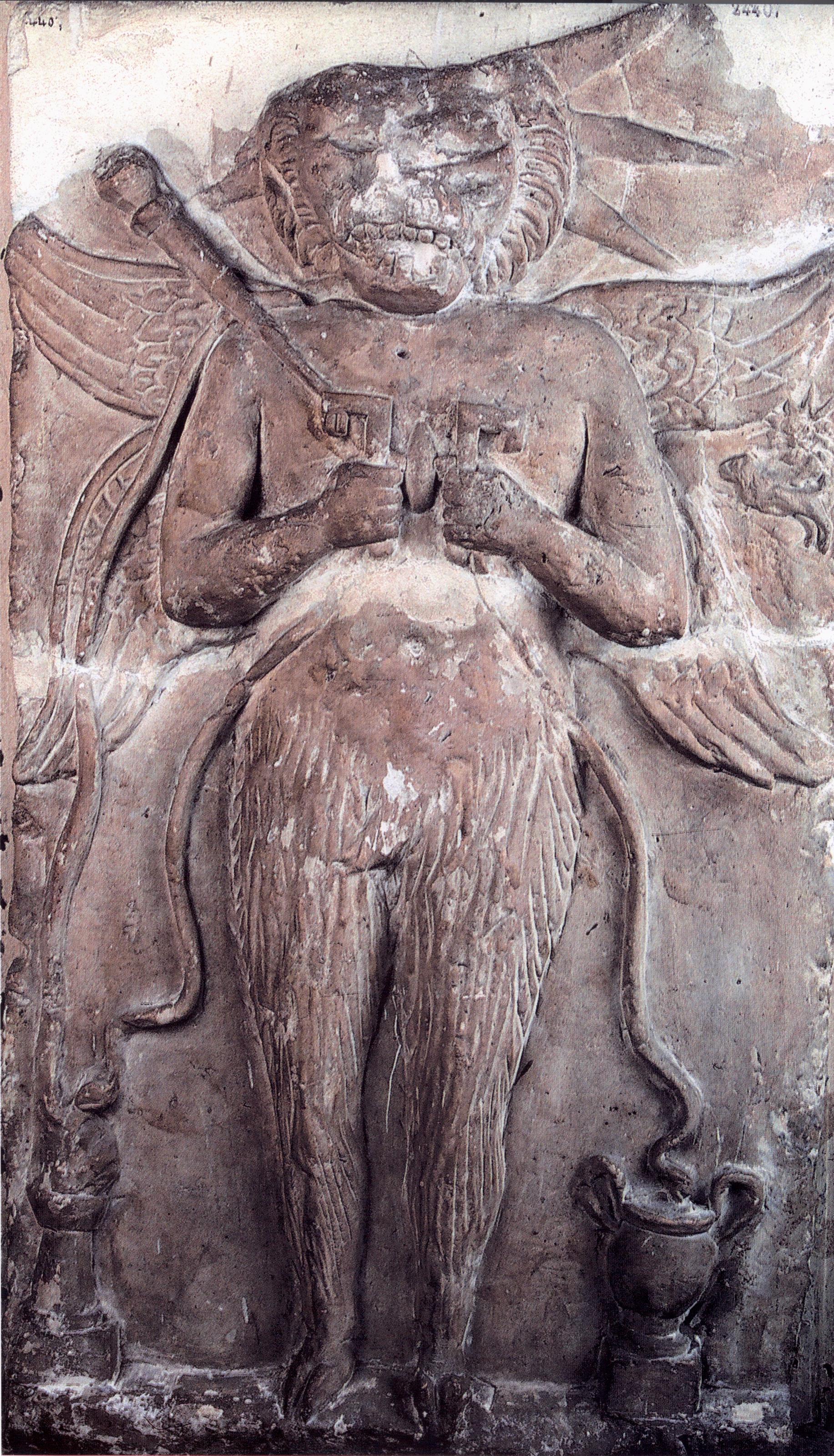------------
AION CIMRM 103 EGITTO III SECOLO A.C .

Relief in limestone (H. 0.98-1.02 Br. 0.57-0.58 D. 0.08) broken in three parts. "Un ritrovamento clandestino dei cavatori di Sebach". Museum of Greek and Roman Antiquities at Alexandria.
Breccia, Cronos mitriaco, 257ff with Pl. (see fig. 36) ;D. Levi in Hesperia XII, 1944, 275 fig. 5; Pettazzoni in AntC. XVIII, 1949, 271 and Pl. II, 4.
Standing Aion with four wings, one pair pointing upwards, the other pair pointing downwards. The god is represented as partly human partly animal. Around the lion's head a nimbus with radiate crown, only four of which are visible owing to damage. Bare arms and breast; the lower part of the body from the hips to the cloven hoofs is covered with shaggy hair. A rearing lion has been represented between the two left wings, above the animal a star. In each hand he holds a key, moreover, the r.h. lifts a torch; between his thumbs along object, probably a lightning.
From each hand a snake is hanging, one of which holds his head over a krater, the other over a small burning altar, which are standing on either side of the god. Creeping up to the altar is a third and bigger snake, coming from between the teeth of Aion' s mouth.
On the relief remnants of a coat of painting have been preserved (golden-yellow, red, blue).
According to Pettazzoni in AntC. XVIII, 1949, 265ff the Aion in general finds its iconographical origin in Egypt. In connection herewith it may be suitable to point out, that Mithras must have been worshipped in Egypt in the third century B.C. A papyrus from Gurob in the Fajoum (J. G. Smyly, Greek Papyri from Gurob (Cunningham Memoirs XII), Dublin 1921, 36ff) contains an inventary of small cattle belonging to the temple properties of Aphrodite, Hermes, Nephtimis and. according to line 10, of Mithras. Of this "Mithraeum", however, no traces have been found.
In a papyrus from Oxyrhynchus from 214 A.D. a certain M. Aurelius Andronicus has the surname of Mithres (U. Wilcken, Grundzüge der Papyruskunde, Berlin 1912, 129; W. Schubart, Einführung in die Papyruskunde, Berlin 1918,343; 353).
Rilievo in calcare (H. 0,98-1,02 Br. 0,57-0,58 D. 0,08) spezzato in tre parti. "Un ritrovamento clandestino dei cavatori di Sebach". Museo delle Antichità Greche e Romane ad Alessandria.
Breccia, Cronos mitriaco, 257ss con Pl. (vedi fig. 36) ;D. Levi in Hesperia XII, 1944, 275 fig. 5; Pettazzoni in AntC. XVIII, 1949, 271 e tav. II, 4.
Aion in piedi con quattro ali, una coppia rivolta verso l'alto, l'altra coppia rivolta verso il basso. Il dio è rappresentato in parte umano in parte animale. Intorno alla testa del leone un nimbo con corona raggiata, di cui solo quattro sono visibili per danneggiamento. braccia e petto nudi; la parte inferiore del corpo, dai fianchi agli zoccoli, è ricoperta di pelo ispido. Tra le due ali sinistre è stato rappresentato un leone rampante, sopra l'animale una stella. In ogni mano tiene una chiave, inoltre, la r.h. solleva una torcia; tra i pollici lungo l'oggetto, probabilmente un fulmine.
Da ciascuna mano è appeso un serpente, uno dei quali tiene la testa su un cratere, l'altro su un piccolo altare ardente, che stanno ai lati del dio. Strisciante fino all'altare c'è un terzo e più grande serpente, proveniente dai denti della bocca di Aion.
Sul rilievo sono stati conservati resti di una mano di pittura (giallo-oro, rosso, blu).
Secondo Pettazzoni in AntC. XVIII, 1949, 265ss l'Aion in generale trova la sua origine iconografica in Egitto. In relazione a ciò può essere opportuno sottolineare che Mitra doveva essere adorato in Egitto nel III secolo a.C. Un papiro di Gurob nel Fajoum (J. G. Smyly, Greek Papyri di Gurob (Cunningham Memoirs XII), Dublino 1921, 36 ss) contiene un inventario di piccoli bovini appartenenti alle proprietà dei templi di Afrodite, Hermes, Nephtimis e. secondo il verso 10, di Mitra. Di questo "Mitreo", però, non sono state trovate tracce.
In un papiro di Oxyrhynchus del 214 d.C. un certo M. Aurelius Andronicus ha il cognome di Mithres (U. Wilcken, Grundzüge der Papyruskunde, Berlino 1912, 129; W. Schubart, Einführung in die Papyruskunde, Berlino 1918,343; 353).
-----------------------------------
CIMRM 103 VOLUME 1
Altezza cm 102 base cm 58
Ritrovato in Egitto .
bassorilievo in calcare " cit testuale UN RITROVAMENTO CLANDESTINO DEI CAVATORI DI SEBACH "
nel 1956 era al Museo greco e Romano di Alessandria in Egitto .
Datazione stimata 300 A. C.
" Aion leontocefalo , 2 chiavi in mano e piedi di gallo o altro .
Dice il Pettazzoni nel suo studio su Aion :
LA FIGURA MOSTRUOSA DEL TEMPO NELLA RELIGIONE MITRIACA
Estratto da " l' Antiquite Classique "
1. XVIII , fascicolo 2
Bruxelles 1949
http://it.wikipedia.org/wiki/Raffaele_PettazzoniSi tratta di una figura del Chronos mitriaco rinvenuta a
OXYRHYNCHOSdall' archeologo Evaristo breccia , e da lui pubblicata nel 1934
( Melanges Maspero , Memoires de l'Institut- te 67 )
Al Museo di Alessandria.
www.tertullian.org/rpearse/mithras/display.php?page=cimrm103http://en.wikipedia.org/wiki/Oxyrhynchus_Papyrihttps://digilander.libero.it/Hard_Rain/Oxyrhynchus.htmTUTTI GLI INSIDER ALLERTATI !!!!!!
IN PARTICOLARE SU BRECCIA
http://it.wikipedia.org/wiki/Annibale_Evaristo_BrecciaIl carteggio completo delle sue lettere, dei manoscritti e delle lastre fotografiche vennero donate nel 1967 dalla moglie Paolina Salluzzi all'Università pisana, costituendo oggi parte delle Collezioni Egittologiche universitarie;
l'archivio completo è consultabile anche on-line.





